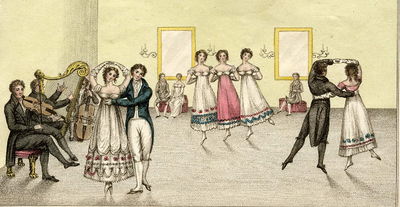Annotation:New German Waltz
Back to New German Waltz
NEW GERMAN WALTZ. English, Waltz (3/8 time). G Major. Standard tuning (fiddle). AABB, AABBC (Campbell): AABBC (Moore). The waltz appears in several publications around the turn of the 19th century, including Thomas and William Cahusac's The Compleat Tutor for the German Flute (London, c. 1798, p. 25), Charles Wheatstone's The Clarinet Preceptor (London, 1801), Goulding & Co.'s The Clarinet Preceptor (London, c. 1803), and James Aird's Aird's 6th and Last Volume of Scotch, English, Irish and Foreign Airs (Glasgow, 1803).

There were other period melodies with the same title, although the all refer to the couple-dance known as the waltz, known in various forms on the Continent since the late 17th century, however, not gaining in popularity until 1778, when it was introduced on the Viennese stage in an opera called The Cosarara,' by Vincent Martin. It was introduced in England in 1790 Baron Newman, however, it did not become popular in that country until the late Napoleonic era, c. 1812, although deemed quite scandalous initially.
Source for notated version: a c. 1837-1840 MS by Shropshire musician John Moore [Ashman].
Printed sources: Ashman (The Ironbridge Hornpipe), 1991; No. 32a, p. 10. Campbell (10th Book of New and Favorite Country Dances), 1795; p. 5.
Recorded sources:
